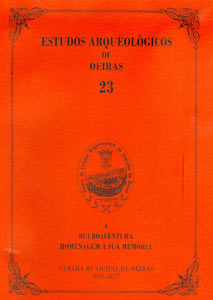O Megalitismo das pequenas antas: novos dados para um velho problema
Palavras-chave:
Architecture, Chronology, Complex, Megalithism, SimpleResumo
The study of the megalithic phenomenon practically follows the development of Archeology as a Science, since the mid-19th century. During this time, one can recognize several stages of analysis, from the first normative readings, that consider this phenomenon as an univocal episode (explaining its different nuances by essentially contemporary cultural factors) to the formulation of the first evolutionary sequences, mainly by Manuel Heleno based on his field works of almost a decade in megalithic monuments in Alentejo. These evolutionary diagrams, conditioned by the historical-culturalist thinking of their Time, result in linear, overly simplistic explanations for a theme as intricate as the origin and development of Megalithism. Basically they advocate, in general lines, a sequential evolution from simple to complex, with the universal, reductionist “shelving” of architectures and votive sets. The basic lines of this approach have remained in use until quite recently. New analyzes, mainly drawn since the 1980s, have presented alternative readings. Some plead for the total reversal of the simple – complex evolutionary sequence, almost like an “involution”; others consent the contemporaneity of several architectural solutions, admitting the cultural and chronological coexistence of simple and complex monuments. The works conducted by Rui Boaventura, mainly dedicated to the Megalithism of Alentejo and the Portuguese Estremadura, sought to order, filter and compile all the available information, as means to provide solid bases of analysis, grounded on critical readings and on the non-biased evaluation of data. In this regard, and as strictly as it was permitted, Rui Boaventura sought to characterize and define the key issue in the study of Megalithism: its actual origins and its various evolutionary levels. In this task, he recognizes the fallibility of linear readings and substantiates his analyses unconditionally on what data demonstrate, in terms of architectures, votive sets and absolute chronologies (preferentially on human samples). In this paper, the authors intend to present a series of small simple megalithic monuments, excavated in collaboration with Rui Boaventura in the areas of Redondo and Monforte, under the projects he directed (COMONPH and MEGAGEO). These are small megalithic monuments, with simple artefactual sets and simple architectural features, of the type that is traditionally assumed to be the representative of a first moment of Megalithism. With an exclusive focus in the Southwestern Iberia, the authors seek to insert these monuments, with all the questions they raise, into the chrono-cultural levels of the megalithic phenomenon in this region, trying as well to define their evolutionary sequences, with regard to the architectural features of monuments, their funerary contents and available absolute dates. It is acknowledged that, taking into account the currently available data, a simple evolution scheme could not be so applicable to the reality under consideration: even if one can accept that a substitution of architectural models had occurred, it would not have been as linear nor as chronologically detailed as normally assumed. In fact, rather than this instantaneous substitution, it seems that a gradual replacement, considerably expanded in Time, of simple monuments by complex monuments takes place, with the coexistence of tombs with various architectural features still during a full moment of the 4th millennium BCE. In this scope, one must also consider the funerary uses of natural caves and artificial caves, apparently contemporary and culturally comparable, according to the generic characteristics of the votive sets. Megalithism is thus a multi-faceted phenomenon, balanced by its own dynamics. Most of the ideas presented herein were widely discussed with Rui Boaventura, and the authors sought to remain faithful to his line of reasoning, which, in general terms (with the elementary personal nuances, of course), they shared.
Downloads
Publicado
Como Citar
Edição
Secção
Licença
Os artigos publicados são da exclusiva responsabilidade dos Autores.
É expressamente proibida a reprodução de quaisquer imagens sobre as quais
existam direitos de autor sem o prévio consentimento dos signatários dos artigos
respectivos.




